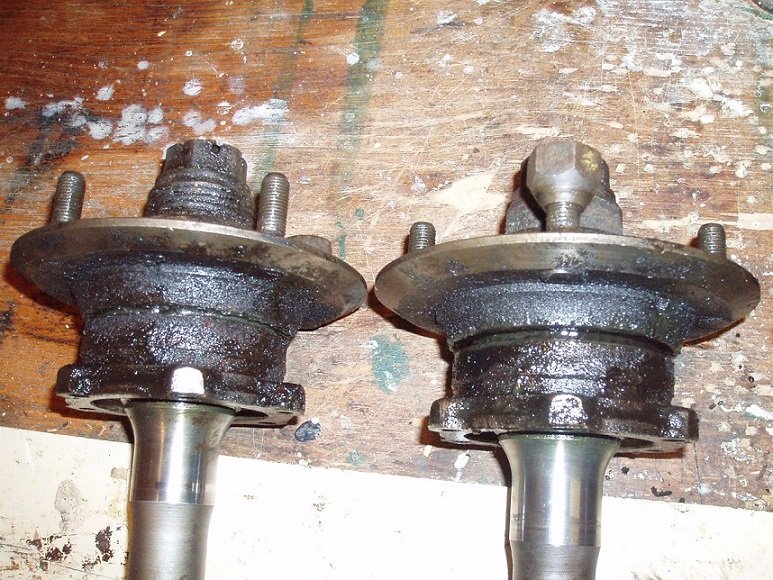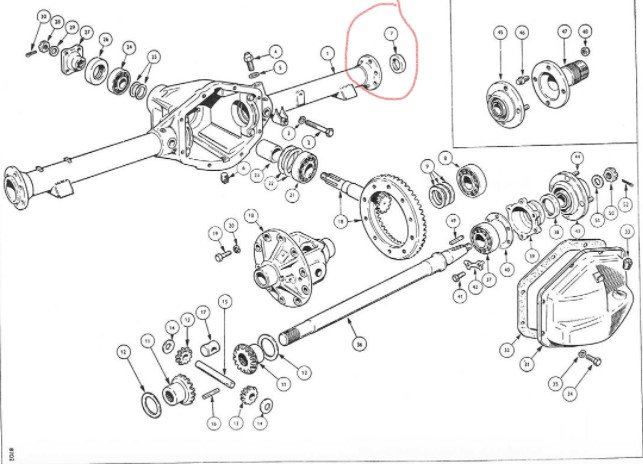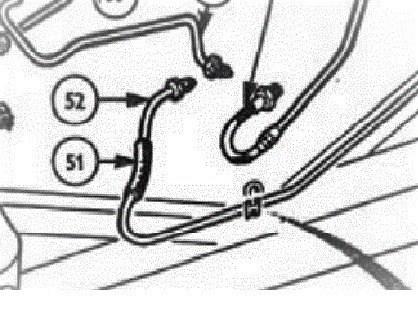-
Content Count
144 -
Joined
-
Last visited
Content Type
Profiles
Forums
Calendar
Posts posted by adriantr4
-
-
Hi
I finally got the last bugs ironed out & drove my '4 a short distance locally. The engine ran really well and the car felt quite strong. I had used ancient brake fluid and braking was very poor. However a bleed with new fluid fixed that.
This is the first time its been on the road in 10 years, and its running magnitudes better than before.
I'd like to thank everyone who gave advice these past three years or so, but a big hand to John Morrison, our co-ordinator, who gave lots of encouragement.
Adrian
-
Hi
I've been working my way through a number of jobs, very ably assisted by this forum, with the goal of getting the car (a '4) mobile after a number of years asleep.
The big day was Saturday, and I was very pleased that it fired up well and ran strongly. A very good sign (I think) is that it responded to carb and ignition adjustments exactly as given by Haynes. In previous episodes, a long, long time ago, I had an awful job getting it to run right as it wouldn't tune up at all. This was due to dud ignition wires, cap, rotor arm, etc. Basically poor sparks under compression I suspect. When the parts were replaced all was well.
Anyhow, back to Saturday and despite a strong start I realised after a few minutes that the windscreen was covered in oil ........... The flexible hose connecting the oil feed from the engine block to the oil pressure gauge had failed, with pinholes. Oil sprayed out, quite dramatic.
I removed the hose and it is very brittle, so I suspect it might be an original part. Certainly very old! The engine in my car is a late '3A, so the hose might be from the late 50's?
The moral of this is to check that hose - bendy = good, rock solid = bad.
As an aside, I did read somewhere of a guy who had an oil pressure gauge pipe let go at the dashboard end, thus dumping oil onto girlfriend. Her reaction was not positive.
regards, Adrian
-
Hi
I'm please to report, that despite a bit of the usual struggle, I got .005 and .004-and-a-bit on the axle end floats. The shim-steel DIY approach worked, but as RobH says, a hole punch is needed. I didnt have a hole punch, so was mucking about with Stanley knives and scissors, but generally failed to cut really clean holes. So, in short, the easiest solution is to accept a delay, measure the existing shims then purchase what new shims are needed.
I found it all do-able, but was thrown at first by each side of the hub affecting the other. However I got much faster and confident. The only real disaster was my lack of three hands when my vintage dial-gauge abruptly let go of its mount when I was adjusting it, and fell face down thus cracking the glass face. I expect a watch repairer can replace it.
So: My real thanks to all posters. The new axle seals are in and not too tricky, I've learned about dial gauges, micrometers and axle end-floats, and the entire braking system got a rebuild as one of several side projects.
I'll park this thread. I'm now building up to starting the car and tuning it up after carbs rebuild, but in the meantime there are a few jobs to do, notably "service" items.
Thanks
-
Hello, and again my gratitude to all contributors.
I've ordered some shim steel - it never would have occurred to me. A very good suggestion. Hence I plan to carefully make what I need. As a backup to that, as I obviously have to pull the hubs again, I'll measure what I have to set the scene for any possible buying of the real shims.
I located my micrometer and gave it a good clean and it came up very well. I didnt really understand how to use it, but I read my Automobile Engineering textbook dating from the early'60s, with the emphasis on Engineering, and this had a very clear section on the use of micrometers. I feel that if it such measurements could be done old-school prior to the digital age, then with a bit of effort I should be able to measure my existing shims.
Thanks
-
Hello again
I though I’d give an update as to where I am with replacing the axle tube seals.
I’ve got it all back together after buying an Imperial dial gauge. But I’m a bit fed up as I had the hubs bolted on fairly firmly with 4 bolts each & I got readings of .005” per side, which is spot on. But when I put the remaining bolts in and tightened it all up moderately hard, this dropped to .002 & 003. The thinnest shim available is .006”, so simply adding this puts it over the limits (.004 to .006)
I think I’ve got a micrometer somewhere, so I’ll need to have it all apart again to measure what I’ve got & calculate a solution. There weren’t many shims – three on one side & two on the other.
I can also see examples of previous work – washers cut with hacksaws, and the hubs only bolted on firmly (ie: see above). Following the good advice here, I checked the axle breather tube which was on almost hand-tight which had an example of the above washer.
The only upside is that I’m getting much slicker at removing & replacing the half-shafts ….
Any thoughts? Anyone got a mixed set of axle shims I could buy?
-
Got it & understood - thanks. Appreciated.
-
Hi
I thought I'd give an update, and again ask a question.
I got the axle tube seals out, but it was a bit of a battle. I broke the head of the handled tool described earlier, and I wasn't using much force. I think the seal removing tool is for non-metal flexible seals. After a few attempts trying to bang in a small screwdriver, and failed experiments with a little puller, all I had done was mark the axle tube ends & inner parts. My next attempt, which was a bit hazardous, was to use a gas blow lamp to seriously heat the seals. I prepared for the worst by wrapping a wet towel around the axle end, got a fire extinguisher ready, sealed off the opposite end, and practiced blocking the fired end if it all caught light.
In the event the seal didn't let go when heated up, probably because it expanded .... but when cooled it suddenly gave in. And the same for the other side.
I've also had a detour replacing the flexible brake hoses and installing new rear brake cylinders and shoes. I followed a recent thread on this, and the cylinders do move in their slot. There is a minor an indent on one side made by the handbrake actuating lever, but this will have to wait. But at least I now I know.
So re-assembly is next. I've cleaned the mating surfaces including the hub spacers. I've bought an Imperial dial gauge.
The scratches due to my efforts with a screwdriver, etc, aren't as bad as I predicted and I've dressed them out, but I thought I might put a smear of WellSeal around the new axle tube seals. However - these are flexible seals. (And double lipped!). WellSeal seems pretty hazardous.
My Question - will WellSeal attack flexible seals? Is this worth the effort?
Thanks, Adrian
-
Hello
Again, my ignorance is shining through .... How do you get the axle tube seal out?
I have the above handled puller, but I'm unsure how to wield it. I assumed the seal is abutted against a flange, so I'm attempting to make on to the metal part of the seal itself, which seems to be quite soft. All I'm doing though is mangling the visible circle of metal. Do I press on and try to destroy the seal & then hook it out? Force in a small screwdriver between the seal and axle tube to distort the seal & then shift it?
(Or, I think I read somewhere of a puller to extract it?)
As ever, all suggestions welcome.
Thanks, Adrian
-
Me too, precisely as described - also from Rimmers ....
And I dimly recall I went round this exact loop years ago when I first got the car.
I think a rear brake hose will fit. The old rear one I took off is about 1cm longer than the old front hoses.
I imagine Revingtons will supply the right part & I'll collect a credit note from Rimmers. To be fair they were very helpful but didn't go for my suggestion for a note in their catalogue.
Any thoughts?
-
Thanks to all, understood. Imperial DTI & base (ebay) now arrived.
regards, Adrian
-
Aha, I get it - think as one axle.
This information is very useful & I am learning a huge amount. I've ordered an imperial dial gauge.
Meanwhile ..... Attached is a picture of the two axle assemblies. There is a fair gap between the bearing housing & hub, particularly on the "problem" shaft, on the right of the picture? This ok? Also can be seen, if faintly, the wear on the shaft.
And I built up the other backplate - shoes & cylinder.
Thanks, as ever, to all posters.
Adrian
-
Hello
Thanks to BlueTR3A-5EKT, and to all posters.
Here is an update on progress so far. I had read that the six bolts that hold the bearing housing to the axle flange can be very tight & had ordered a six-point quality socket.
I decided to give it a go (unfortunately before reading BlueTR3A-5EKT's above post). To my surprise there were no tab washers on either side, and the RHS bolts came undone very easily. They were up pretty firm, but no more than that. In place of the tab washers were split washers. Perhaps in its past life - its a US import - diff work had been done? The diff seal is leaking a little too.
I pushed & pulled the right hand side hub, as expected there was no discernible play. I undid the bolts & extracted the half-shaft, and had a trial practice at putting it all back. All ok. I then replaced the brakes & wheel cylinder, much easier on the bench. I discovered the old cylinder had seized solid.
So far so good. I then went through the same process, and the left side was the same - bolts up moderately tight but no problem to undo. With the bolts freed off I again pushed & pulled the hub. To my alarm, there is about 1/8 inch play. I tightened it all back up up, but the same result?
Suggestions?
This LHS half shaft does have wear, I can feel it with a fingernail. And this is the problem leaky side - it smells of hypoid. A fair amount of oily grease in the tube.
The RHS tube was awash with just grease - probably me and others in past times over-keen with a grease gun. There is no wear on the RHS shaft by the seal. Looks ok.
All comments gratefully received.
Adrian
-
Thanks for the good advice. I've ordered the seal pick, and I'll also check out the breather tube.
Also mulling a dial gauge.
Adrian
-
Of no particular import - I got a "tractor place" to Waxoil or similar my '4 years ago. When I parked it in grass just after the work was done, it looked like an oil tanker had just run aground & ruptured ....
Adrian
-
Hello
Thanks very much indeed. I think I've finally grasped it. And I'll put my 3-leg puller back in it box....
Its appreciated, really. I'll give it a bash (so to speak). And the speedi sleeve may well be on the cards. But I will be taking a few deep breaths before I pull the shaft!
Adrian
-
Hello
I've (still) thinking about replacing the axle tube seal (see picture). My axle leaks.
I've studied the Hayes manual, but I'm rather nervous about this procedure. However, I have a specific questions:
- I have a three-leg puller which neatly fits the hub. Will this do the trick?
- Assuming I can get the hub off, and then can remove the bearing housing as a single item, can I then swap the seal without touching the half-shaft?
I'm doing this as a short term fix just to get the car mobile.
Alternatively, how easy is it to withdraw (and more worryingly for me - re-install) the half shaft?
I'm going to assume that the hub bearing is ok - but if it isnt then I might do the entire bearing & seal replacement. But I dont have bits of pipe to tap in seals, etc.
I'm also going to assume that its all do-able if the puller can do its job and the hub isnt stuck fast: all is needed is confidence? i have asked similar questions before, so I'm now aware the hub can be on very tight.
All suggestions, no matter how obvious, are very welcome.
Thanks, Adrian
-
Hi & thanks for asking.
Yes - out of fuel. My starting technique is to squirt a bit of "Holts Cold Start" aerosol into the carbs intake, as if it was a reluctant lawn-mower, after plug removal & spinning it to get the oil pressure up. Anyhow, after a few tries it started running on all 4 & smoothed itself out.
It isnt running well, and rather lumpy - but I expect the ignition & carbs need significant adjustments. What was rather rewarding was the enthusiasm of the fuel pump - dont think its ever been this effective - the surprise that the electrical/charging system seemed to work, and that fuel lines & carb connections are dry.
Next is a brake rebuild, and the radiator is suspect.
-
I got it to run ............
-
Thanks for the support. I'll try more fuel! The car is in rathe poor shape, but the plan is to move it under its own power.
regards, Adrian
-
Hello
This afternoon, after a pause of about 7 years and some protracted refurb work of fuel tank, fuel lines, carbs, hydraulics, pedal box etc, I finally put petrol in the tank, hooked up the rather tired battery and behold - It Started! But only briefly.....
Still, a Start is a Start. It ran very badly and conked out after a few moments. Checking for problems I realised I had rather stupidly omitted a carb float - but there was very little fuel in the bowls. I have a 3A type pump with the priming lever, and although it had worked well earlier in the day (and much better than years ago) it now wasnt doing much, apart from a gasping noise when the carb end was disconnected. The glass fuel bowl is full. It could be the pump/valves have failed - but I suspect I'm out of fuel. I had put about half a can of petrol in, and it had flowed quite spectacularly with the line to the pump input free.
Hence: lesson 1 - sparks (yes), fuel (no) = no start
Any other thoughts? I checked out the fuel pump as part of the refurb and all looked well.
regards, Adrian
-
Hello (again)
I am pressing on with my glacial-speed work on my '4, with a view of getting it running again. Or at least moveable. With the aid of the Forums, so far I have repaired the pedal box, clutch hydraulics, fuel tank, pump and have moved through the system to the carbs. These are now removed awaiting a gasket set rebuild.
I was surprised that the vacuum line from the carb(s) to distributor was blocked. This might explain at least one reason for its poor running the last few times it was on the road, about 7 years ago. I realise this can be deduced with a timing light if the the ignition advance isn't working & the vacuum advance in the distributor (a likely culprit) is ok
Anyhow - another thing to check if your car is running, but not that well.
I was very lucky to have a reel of wire which I could feed in to prod my vacuum pipe, then I found I could blow through it, followed by a good squirt of freeing oil.
Thanks
Adrian
-
Hello
All points noted. My thanks to Stuart & James. I'll press on.
Adrian
-
Hello
The olive is loose on the pipe. A rather stupid question: This is a Compression Fitting I presume - doing the union up as mentioned by previous posters will squash everything together? Any advantage to (say) brazing the olive on?
I have said new olive & new shiny pipe that awaits fixing to car (item 52 in diagram) - after a pause of several years.
Thanks, Adrian
-
My thanks to RogerH & Stewart. I'll press on. (Anyone got a mounting plate?)
regards, Adrian






TR4 rear brake leak (I think)
in TR4/4A Forum
Posted
Hello
The brakes on my '4 went soft during a run. On my return the master fluid was very low - and no brake lights either. I had hoped to blame the pressure switch which is probably 60 years old, but I have discovered that the right rear wheel drum and all components are wet. This is disappointing as I rebuilt everything with help from this forum - rear axle seals, back plates cleaned up, new rear cylinders and shoes, plus hoses and new master cylinder. Its also a back to the start again as I began with the axle seal rebuild when I noticed a leak before.
It might be the axle seal again (other side fine, plus all brake connections ok) but I think its the cylinder. It doesn't smell of hypoid either. Just very oily.
Anyhow, I'll get the wheel cylinder off to check. Which leads me to my question - any reports of wheel cylinder failures? I dont read this forum very often, but I hope to visit Wessex group soon now I have moved house - and drove the car, virtually untested and in generally poor shape from Aberdeen to Salisbury!
thanks, Adrian